Fast Facts
Also Known as: Bharat Chhodo Andolan
Launched on: 8 August 1942
Launched at: Bombay
Launched by: Indian National Congress
Nature of Movement: Mass Protests
Objective: Withdrawal of British from India
The Indian National Congress launched the ‘Quit India Movement’ on August 8, 1942 at the Bombay session of the ‘All-India Congress Committee.’ The sole aim of the movement was to force the British to withdraw from India. The movement was launched under the leadership of Mahatma Gandhi, who delivered an exhilarating ‘Do or Die’ Quit India speech at the Gowalia Tank Maidan in Bombay (now Mumbai). Even though the British were concentrating all their energy in the Second World War, they were prepared to act against the Congress leaders, and almost all the main leaders of the Congress were imprisoned within hours of the launch of the movement. Many Indian industrialists and other groups did not support the movement for various reasons. This made sure the movement initiated by Gandhi had no major impact in terms of attaining immediate independence. However, it did play a crucial role leading up to India’s eventual independence in the year 1947.
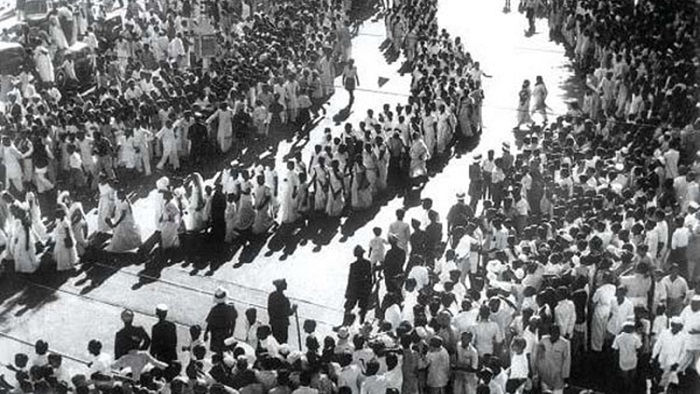
Image Credit : http://www.freepressjournal.in/webspecial/quit-india-movement-all-you-need-to-know-in-10-points/1118275
Background
During the ‘Second World War’ in 1939, Indian soldiers were sent to fight for the British against the German troops. On October 10, 1939, the ‘Congress Working Committee’ passed a resolution, which stated that Indian soldiers should not be sent to the war without people’s consultation. Seven days later, the Viceroy issued a statement in response to the resolution, in which he claimed that the British’s objective in waging wars was to reinforce peace in the world. He also promised that the British administration would make Indian-friendly modifications to the ‘Act of 1935’ once the war comes to an end. However, the Viceroy’s claims could not convince the Indian leaders, who were looking to put further pressure on the British government.
The Congress ministers from across eight provinces resigned as they were instructed to do so by the High Command. Meanwhile, the ‘Conservative Party’ assumed power in Britain as Winston Churchill was succeeded by Neville Chamberlain as the Prime Minister of Britain. Though the Conservatives failed to consider the demands put forth by the Congress, they did concede to some of the demands in order to gain the support of the Indians at a time when the war had intensified, which had worsened Britain’s state.
On August 8, 1940, the Viceroy of India issued a statement, requesting full co-operation from the Indians during Britain’s campaign in the ongoing ‘Second World War.’ In return, the Viceroy promised to add more Indian members in the ‘Viceroy’s Executive Council’ and to consider Indians’ rights to form their own constitution among other tactical benefits. As expected, the deal was rejected by the Congress and the ‘Muslim League’ too did not accept the proposal as the Viceroy had failed to mention about the creation of a separate Muslim state called Pakistan.
At a meeting held by the ‘Congress Working Committee’ in Wardha, Mahatma Gandhi, who was dissatisfied with the Viceroy’s proposal, spoke about launching a movement that would display individual civil disobedience. Gandhi then chose Vinoba Bhave to initiate the movement, which encouraged many to initiate fiery protests all over the country. Many protestors, who were requesting their fellow Indians not to support Britain in its war campaign, were arrested. On December 3, 1941, the Viceroy ordered the release of almost 14,000 Indians, who were arrested in connection with the protests. The acquittal order was passed with a hope of gaining Indian support in the war as the situation in Europe had become critical, thanks to Japan’s attack on Pearl Harbor.
In March 1942, the British sent a delegation to India, which was led by the then Leader of the House of Commons, Stafford Cripps. Hence, the delegation came to be known as ‘Cripps mission.’ The sole purpose of the delegates’ visit was to convince the ‘Indian National Congress’ to support the Britain whole-heartedly in its war campaign. In return, the mission promised distribution of power from the Britain administration to an elected Indian legislature. However, the talks failed to produce any results as the mission failed to address the key demands of the Indians, including their right to form self-government.
The failure of ‘Cripps mission’ was one of the key factors contributing towards Gandhi’s decision to call for ‘Bharat Chhodo Andolan’ (Quit India Movement) on August 8, 1942. The movement was initiated with a hope of attaining immediate independence from the British. Gandhi’s call for immediate independence was also heavily influenced by his fear of a possible Japanese invasion of India and the supposed British inability to defend the India during such a situation.
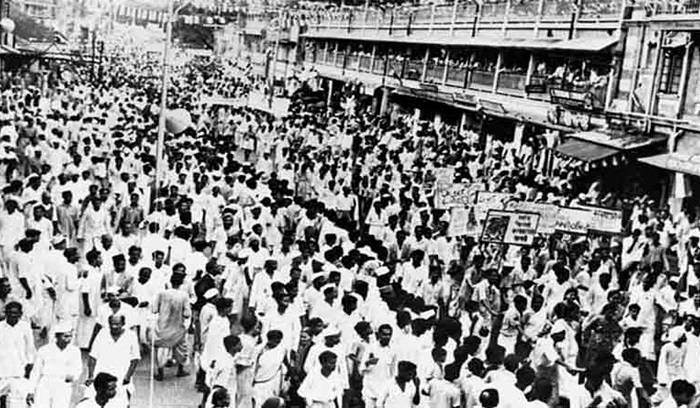
Image Credit : http://www.samacharnama.com/knowing-about-quite-india-movement-on-9-august/quit-india-movement-9-august/
Opposition
Not surprisingly, Gandhi’s ‘Quit India Movement’ faced opposition from several Indians, who chose not to support the movement for various reasons. The Congress’ draft that proposed massive civil disobedience if the country doesn’t attain immediate independence was opposed by the prominent leader and Gandhi’s loyalist, Chakravarti Rajgopalachari, who chose to quit the Congress. Though leaders like Maulana Azad and Jawaharlal Nehru were apprehensive of the call, they chose to remain loyal to Gandhi and believed in the Mahatma’s decision. However, various other leaders, including Allama Mashriqi opposed the Congress Working Committee’s resolution, stating that the movement was ‘pre-mature.’ He also said the Congress must first hold a discussion with the ‘Muslim League’ pertaining to the creation of Pakistan and should then consider all the other groups in order to make a demand to free India.
Several political groups, such as the ‘Muslim League,’ ‘Rashtriya Swayamsevak Sangh,’ ‘Hindu Mahasabha,’ and the ‘Communist Party of India’ did not support the movement. The ‘All-India Muslim League’ feared the Muslims will be oppressed by the Hindus if the British decided to leave India without creating a separate state for the Muslims. Hence, it did not support the movement, which worked in favor of the British. What also worked in favor of the British was the silence of ‘Rashtriya Swayamsevak Sangh’ (RSS). Led by M.S. Golwalkar, RSS failed to join the movement as it did not want to go against the ruling government. This decision by the RSS attracted criticisms from general public as well as from certain important members of the RSS itself. However, the organization continued its stance against ‘Quit India Movement,’ which pleased the British authorities.
Other important political organizations like the ‘Communist Party of India’ and the ‘Hindu Mahasabha’ too did not support the movement. While the ‘Hindu Mahasabha’ stated that the movement will bring about internal disorder, the ‘Communist Party of India’ supported the British during the war as it wanted to support Soviet Union in its battles against the Hitler-led Nazi Germany.
What further weakened the movement was the fact that many Indian businessmen and students also did not support the movement. The businessmen supported the war as they were enjoying huge profits through heavy wartime spending, while many students simply ignored the movement as they were focused on the progression of Subhas Chandra Bose in his effort to free India.
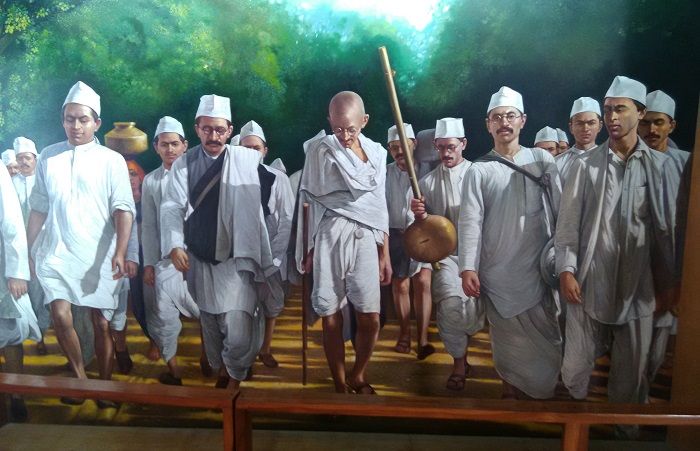
Image Credit : https://commons.wikimedia.org
Violence
Renowned British author John F. Riddick stated that the ‘Quit India Movement’ was responsible in the destruction of 155 government buildings, including 70 police stations. He also said that the movement led to attacks on at least 250 railway stations and 550 post offices. Throughout India, there were 2,500 instances of telegraph wires sabotage by the protestors.
In Bihar alone, 57 battalions of British troops had to be deployed to restore order in the region.
In Uttar Pradesh, people started breaking into jails, releasing many Congress leaders. Some local rulers even proclaimed their own rule.
In West Bengal, the peasants were engaged in violent activities as they were angered by the fact that the British government had introduced new taxes and had even forced them to export rice.
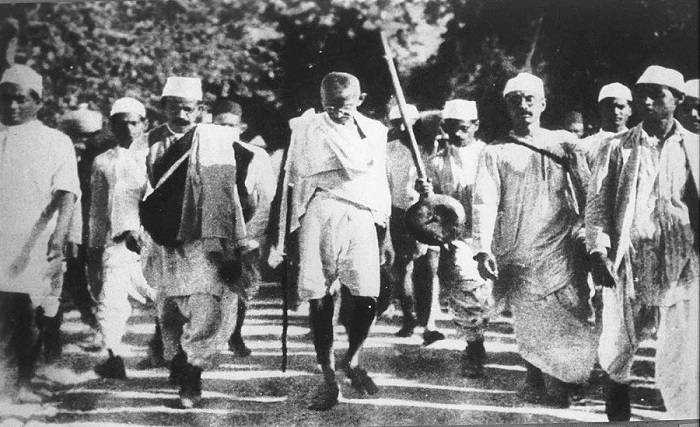
Image Credit : https://caravandaily.com/portal/75-years-of-quit-india-movement-when-hindutva-brigade-ganged-up-with-british-rulers-and-muslim-league/
Suppression of the Movement
By 1944, almost all demonstrations as part of the movement had been suppressed. The British had imprisoned Gandhi as well as all the members of ‘Congress Working Committee.’ In fact, many prominent Congress leaders were isolated from the rest of the world for more than three years. While Gandhi’s personal secretary, Mahadev Desai, and his wife, Kasturbai, died in prison, Gandhi’s own health was fast deteriorating.
Since many demonstrations were violent in nature, the British had responded with mass detentions as more than 100,000 people were arrested, which eventually led to the suppression of the movement.
Many civilians and protestors were shot dead by the police and there was a general feeling that the ‘Quit India Movement’ had failed miserably, which depressed many nationalists.
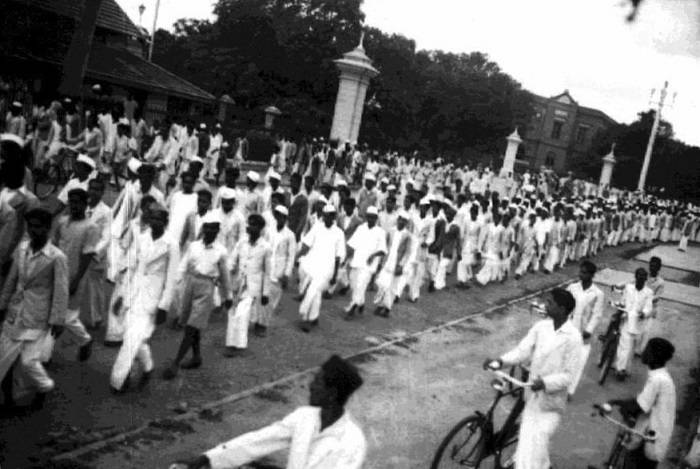
Image Credit : https://en.wikipedia.org/wiki/Quit_India_Movement
Impact of the Quit India Movement
Though the movement initiated by Gandhi had no major impact in terms of attaining immediate independence, it did play a crucial role leading up to India’s eventual independence. Firstly, the movement kept the Congress Party united through thick and thin and the movement established a fact in the minds of the British that to attain complete freedom the Indians were ready to dig deeper than they had expected. The movement also conveyed to the British that India had the support of global leaders, as the then American President Franklin D. Roosevelt had urged the British administration to consider at least some of the demands put forth by the Indian leaders.
Another major impact the movement had on the independence was the destruction it had caused through various protests and violent activities. Since the movement was responsible in the destruction of many edifices and facilities, the British had to reconstruct many facilities if they were to rule India for a longer period of time. However, destruction and monetary loss incurred by Britain during the ‘Second World War’ made sure the British administration was left with insufficient funds to rebuild India. Hence, the British understood that it was almost impossible for them to govern India in the long run. Once the war came to an end in 1945, the only question that lingered on many British minds was how to exit India peacefully and gracefully.


